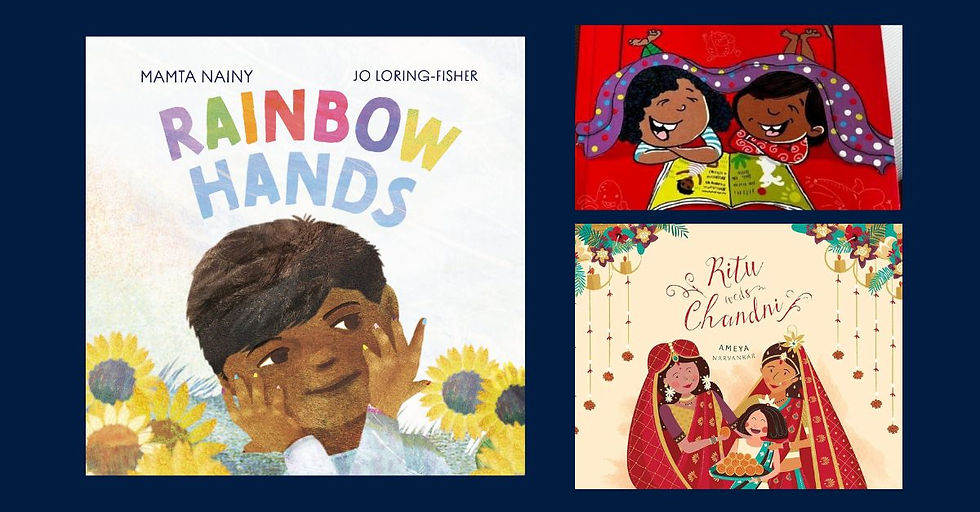Talking to Kids About Sex, Gender & LGBTQ+ Identities: A Quick Guide for Indian Parents
- Sonal Giani
- May 27
- 3 min read

One of the most common questions I get as a gender and inclusion educator is: "How do I talk to my child about gender, sex, or LGBTQ+ topics?" Especially in India, where these conversations haven’t always been easy or open.
Here's the good news: You don't need to have all the answers. You just need the right stories to start the conversation.
I've put together a short, thoughtful list of age-appropriate books (many by Indian authors!) to help you talk to your child — whether they're a toddler or a teenager — about bodies, identity, and inclusion. Think of these as gentle entry points for big conversations.
TODDLERS (1-4 years)
Keep it simple and visual. Toddlers are learning how the world works, so this is a great time to introduce ideas about different kinds of families, feelings, and how to talk about their own bodies.
En Kudumbam by Vanitha Veerasamy (Tamil-English): A delightful board book that shows families of all kinds – including one with two dads. Brightly illustrated and bilingual, it normalizes diversity in a subtle, joyful way.
Rainbow Hands by Mamta Nainy: A gentle, lyrical story about a boy who loves painting his nails in different colours. When his mother joins in, it's a tender affirmation of self-expression and acceptance.
The Many Colours of Anshu by Anshumaan Sathe: Anshu doesn’t want to be "just a boy or just a girl." Through colours and clothes, this book offers toddlers a fun and visual way to explore gender identity beyond binaries.
EARLY READERS (5-8 years)
This is the age when kids are learning rules and starting to question them. They can begin to explore empathy, difference, and fairness. Use stories to help them see beyond stereotypes.
Ritu Weds Chandni by Ameya Narvankar: A colourful celebration of a lesbian wedding in an Indian family. Young Ayesha bravely supports her cousin Ritu against those who disapprove. It’s a beautiful way to introduce the idea of same-gender love and allyship.
Guthli Has Wings by Kanak Shashi: Guthli knows she’s a girl, but everyone around her says otherwise. This story tackles gender identity in a simple, heartfelt way and encourages kids to embrace who they are.
Sadiq Wants to Stitch by Mamta Nainy: Set in Kashmir, this is about a boy who loves embroidery but faces resistance. It beautifully challenges the idea that some activities are only for certain genders.
PRE-TEENS (9-12 years)
This is the age of curiosity and self-awareness. Kids are starting to notice body changes and ask deeper questions. They need accurate information and stories that reflect real-life situations.
The Red Book by TARSHI: A well-loved Q&A guide created for curious young people. It covers everything from puberty to attraction and consent, all in a matter-of-fact, inclusive tone.
How I Got My Belly Button by Anju Kish: A bold and fun Indian sex-ed book that talks about where babies come from, how bodies change, and why it's all normal.
Reva and Prisha by Shals Mahajan: A warm and funny chapter book about twin sisters and their two moms. It normalizes queer families while focusing on day-to-day adventures and sibling love.
TEENS (13+ years)
Teens crave honesty and respect. They're figuring out who they are and where they belong. These books tackle big themes while affirming every teen's right to feel seen.
Talking of Muskaan by Himanjali Sankar: Muskaan faces school bullying after being outed. Told from different points of view, this is a powerful novel about identity, stigma, and friendship.
Slightly Burnt by Payal Dhar: Komal’s best friend comes out to her as gay, and she has to rethink her own beliefs. A coming-of-age story about friendship, trust, and standing by the people we love.
The Blue Book by TARSHI: A companion to The Red Book, but for older teens. It covers relationships, sex, consent, identity, and emotional wellbeing. An excellent, reliable resource.
These books won’t just help your kids understand the world. They’ll help you grow as a parent too.
Whether you're reading together or handing them a book to read alone, it's a powerful way to say: "You are safe to ask questions. You are safe to be you."
Let’s raise children who are informed, empathetic, and unafraid to be themselves.
Start small. Stay curious. Keep talking.
[Save this post, share it with a fellow parent, or drop a comment if you want a detailed list with links!]



Comments